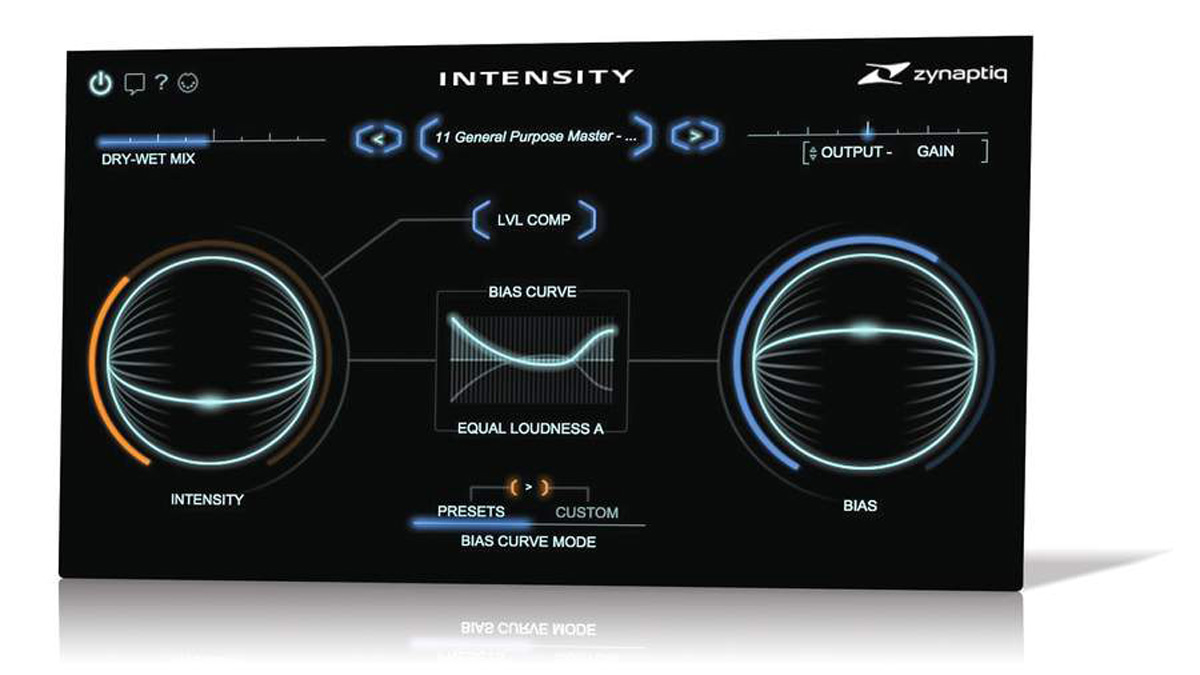MusicRadar Verdict
A genuinely groundbreaking plugin, Intensity costs a pretty penny but does truly amazing things to full mixes and individual tracks.
Pros
- +
Just... works!
- +
Easy to use once understood.
- +
Customisable Bias curves.
Cons
- -
Can do slightly odd things with reverb tails at times.
MusicRadar's got your back
The latest entrant into Hannover-based developer Zynaptiq’s range of innovative, ambitious plugins, Intensity is a sort of cross between a dynamics processor and a dynamic EQ that promises, quite simply, to improve the sound of anything you send its way.
Zynaptiq describes Intensity as like an artificially intelligent “infinite-band compressor that threshold-less-ly operates relative to the input signal”, before going on to say that it’s “absolutely not a compressor”. Apparently, the engine is based on the techniques used in facial recognition algorithms, although at no point is it made clear what that equates to in practical terms.
Ultimately, this is one of those out-there effects that kind of defies description and just has to be used and heard to be appreciated. Zynaptiq suggests that it’s a plugin you’ll want to use on everything you do, from individual instrument channels to buses and full mixes, as it simply makes stuff sound better. Well, it would, wouldn’t it?
Power balls
The plugin (VST/AU/AAX) is largely operated using one main control: the Intensity ‘ball’ (don’t worry, it’s just a slider, really). This deploys the aforementioned algorithm to ‘intelligently’ increase the levels of those parts of the signal that it deems to be “details” and defining characteristics. Think the body of a kick drum, the sheen of cymbals, the sparkle of a vocal, the meat of a bass guitar, etc.
The process can be applied evenly across the whole signal, or - as is more likely in almost all scenarios - ‘sculpted’ using the Bias control, which you can read about in Totally biased below. As raising the Intensity invariably boosts the overall level, a Level Compensation function is on hand for automatically matching the output gain to the input level.
Totally biased
The bipolar Bias control applies an EQ-style cut/boost curve to the Intensity parameter, for emphasising or de-emphasising particular frequencies, by a maximum of 12dB. 11 preset curves are included, and adjustments to Bias are visualised within the curve display - until you let go of the control, whereupon the graphic disappears. We’re not sure why it can’t just be left in place.
If none of the preset Bias curves are doing it for your source material, you can switch to Custom mode and draw your own. This gives you nine vertical sliders with which to shape the ‘breakpoints’ in the curve at fixed frequencies from 50Hz to 17kHz. Any of the preset curves can be flown in as starting points, and a series of buttons below the display enable instant doubling and halving of the slider values, inversion of the entire curve, and resetting of all sliders to zero. Bias makes it easy to focus Intensity on particular areas of the frequency spectrum.
The remaining two controls, Dry-Wet Mix and Output, are rather more conventional. Output adjusts the final, dry/wet-mixed output level by up to 12dB up or down, and can optionally pass the signal through a soft-knee limiter that doesn’t have to be pushed far at all before heavy saturation starts to kick in. The Mix control proves to be almost as important as Intensity and Bias, as this is the kind of processor you’ll often want to run in parallel rather than 100% full-on. Like other Zynaptiq plugins, it’s incredibly easy to go too far with Intensity, and lowering the Mix blend can go a long way towards bringing it back into line.
Intense flavours
Intensity is yet another remarkable addition to Zynaptiq‘s roster of futuristic devices - a unique and high-tech production and engineering tool that gets as close to feeling like ‘magic’ as software ever does. As mentioned, it really does need to be handled with care, and it can do slightly odd things with reverb tails at times; but get it right through considered tweaking of the Bias and Mix parameters and the results can be absolutely stunning, improving whatever’s sent through it in terms of clarity, separation, ‘air’, presence and vibe, whether that’s the elemental components of a drum track, the nuances of guitar line or vocal, or the sonic aggregate of the master bus. Sliding up and down the functional scale between effortless ‘quick fixer’ and serious finalising tool, this is a plugin that every producer needs to try.
Computer Music magazine is the world’s best selling publication dedicated solely to making great music with your Mac or PC computer. Each issue it brings its lucky readers the best in cutting-edge tutorials, need-to-know, expert software reviews and even all the tools you actually need to make great music today, courtesy of our legendary CM Plugin Suite.

